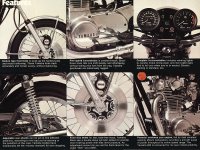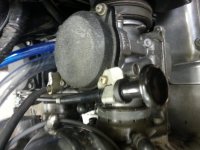Hi playmates,
Bet you've wondered where I've been, (Maybe not.) Well actually I've been doing work on the bike but not a lot at a time, and not posting.
I've been for my first ride along the lane. And Gary, I can relate... No... dammit.
Gary's question relates to the repair I did to my tachometer. It does nothing and then when it is revved the needle whizzes around the dial face. It DID work for a while. At least for the few start ups I've done. But obviously hasn't held up at all. Maybe with my new found soldering skills I can solder the part and not use a fillet of superglue. I'll have it apart and see what's going on. Later.
Where I'm at:
Everything is done and the electrics, lights and indicators all now work.
I need to test the charging but I didn't have faults before (LOL, ran when parked.)
Clearly the ignition all works still.
I've knocked up a choke (kept photos so Ill post them later.) Not a great bit of work. The BMC Mini choke cable was a pile of **** and I don't like the bracket I've bodged. It works though.
Adjusted the clutch after a bit of enthusiastic rocking back and forth to free the plates. Top tip - make sure you've screwed the side case down properly all those months ago before you try adjusting and wonder "what the Hell is going on?". Oh, you do that, do you? I didn't.
Wires for neutral light were discovered hanging but that works now. Wonder of wonders. New clutch cable and it is a piece of cake to pull in and.... I can select neutral. I've NEVER been able to do that. Slick as butter. It will probably start slipping later.
The electric start sounds like a bag of spanners. It always did. But I'm pleased all those years ago I didn't waste my money on new bendixes ect. Now I know how to fix it. But it starts easy enough on the kickstart.
Front brake all assembled and bled. The bleeding was done by the local bike shop. I've bled brakes before but never without either a. taking a week. b. getting fluid on the paintwork. c. getting fluid in my eye. After several weeks of putting it off I thought "Oh, sod it. I did everything else myself."
After my little test ride I noticed a slight weep of oil on the left hand side which might be coming from the base gasket region. The bike had been running for about 20 minutes by this time. There was also smoke oily smoke coming from the front near the right hand exhaust pipe. So I'm think the head nuts need torqueing down. There was slight tendency to hanging idle which wasn't the case before. Head nuts have never been touched to my knowledge. All thoughts welcome. Noticed a small pimple of oil on one of the dome nuts under the engine.
But I've burned my elbow on the exhaust. So that's it for today. Next address some of those points and then a short trip down the sea-front. A couple of miles and If I don't have to push it back from there trip to my mates house. About 10 miles.
There's a good 6-8 weeks of good weather left I hope. So I'm a biker again.








